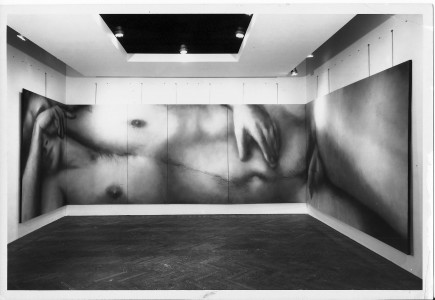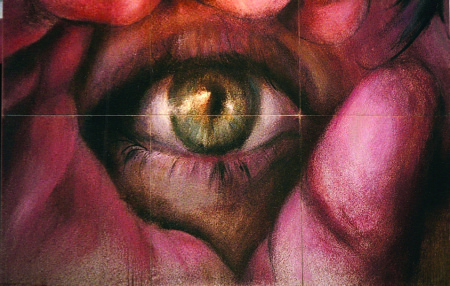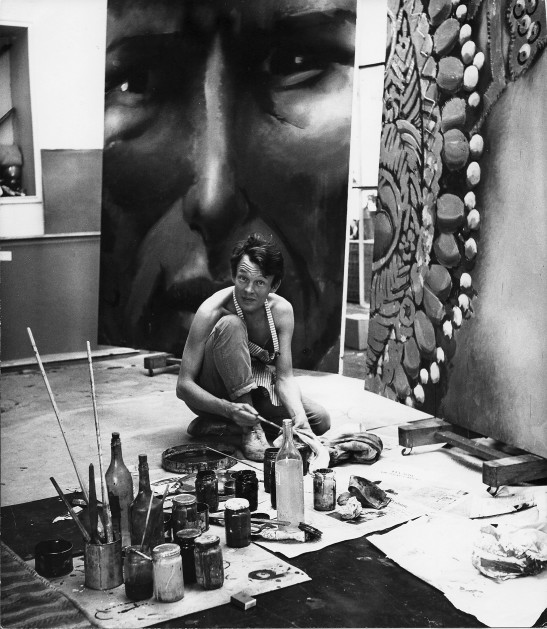Harold Stevenson is a tiny 84-year-old man wearing a knit shirt with a frayed collar. He lives in a log cabin nestled in a small pine forest outside of Idabel, Oklahoma, his hometown.
Idabel is far into southeastern Oklahoma—if you were to roll a basketball from the top of the hill by Harold’s cabin, it would stop near Texas. Harold’s porch has rotten boards covered by rugs, and his shepherd mixes are fond of licking my ears. Behind his cabin is a huge storage room/studio stacked with the dusty detritus of his glamorous life: half-finished paintings of nude men, frescoed rococo furniture, and photo albums from his Hamptons years.
Harold has been an artist since he was four years old and has never thought about being anything else. He once mounted a four-story painting onto the Eiffel Tower. His most famous work is called The New Adam; it is an 8-feet-tall by 40-feet-long male nude.At the center of that painting is an uncircumcised penis—“in the Guggenheim, a Jewish museum!”
When living in Athens, Paris, London, New York City, and Venice, Harold always carried Idabel with him. Ask him about his close friend Andy Warhol, for whom Harold helped coordinate his first gallery exhibit in New York City, and Harold will quickly divert to anecdotes about Helen Rose, the girl who lived across the street from his boyhood home. Ask him what his parents thought about Igor Stravinsky, Anthony Perkins, or any of the other luminaries whom Harold brought to Idabel over the years; ask him, and he will tell you that his parents didn’t think much of them. Then he will go back to waxing about Helen Rose. Despite living everywhere and “meeting everyone of importance in the world,” Harold claims he “never left Idabel.”
“I was the most celebrated person to arrive in Idabel, and I arrived by birth, on March 11, 1929, in a brick bungalow on Avenue A,” Harold says as we sit on his porch. He says by age four he was already an artist. By age 10, he claims to have been un-teachable by local art instructors. So Harold acquired studio space in a three- story building downtown.
“I painted all the people who came there, and that was everybody,” he says.
Mitchell Algus, Harold’s gallery representative since 1992, recalls asking Harold if he was teased for being gay in school. Harold replied, “Honey, I owned that school.”
“I was a local phenomenon,” Harold tells me.
At age 17 Harold began attending the University of Oklahoma, where he met the man who would become his longtime lover, a Choctaw named Lloyd Tugwell. At the urging of architect Bruce Goff, Harold moved to New York City in 1949. On his first day there, Harold seduced a “startlingly beautiful” male ballet dancer. Later, Harold met Alexander Iolas, the Hugo Gallery’s proprietor, and soon earned patronage and gallery support. With Iolas’ help, Harold set up a show for his new friend, a Ruthenian American from Pittsburgh named Andy Warhol. Iolas also connected Harold to major surrealist painters of the era: Pavel Tchelitchew, Max Ernst, and others.
Harold spent most of the 1950s in New York City, and then moved to Paris towards the end of the decade; gallerist Iris Clert was Harold’s major supporter there. Harold painted his most famous works in Paris. These include Eye of Lightning Billy, a colossal painting of a hand with an eye in the palm. This painting was included in the International Exhibition of the New Realists at the Sidney Janis Gallery in 1962, considered the landmark exhibit in Pop Art’s popular emergence. Harold’s work was displayed alongside pieces by Warhol, Roy Lichtenstein, and Robert Indiana.
Next was The New Adam, the aforementioned monumental nude in the Guggenheim. The uncircumcised model for the painting was the actor Sal Mineo, best known for his role in Rebel Without a Cause (“He was a sweetheart person, and kind of stupid,” Harold says).
Then there was El Cordobes, a four-story portrait of the famous Spanish bullfighter that was affixed to the Eiffel Tower in 1963. There are pictures of Harold smoking a cigarette in front of the installation, standing next to Ms. Clert and designer Yves Saint-Laurent. Harold, handsome with a sideways part, looks as if he’s in the middle of telling everyone a joke.
* * *
After Harold finishes his catfish at David Beard’s, we take a driving tour of Idabel.
“There wasn’t anything here,” Harold says as we drive down Washington Street, past Denison Cemetery (where Lloyd is buried), past newer subdivisions, and a Braum’s. Harold is fond of the breakfast at Braum’s, he says. He shows us his old brick bungalow and Helen Rose’s old stone house.
I turn onto Central Avenue and drive past a strip of empty Plains Commercial buildings.
Downtown Idabel has almost disappeared, he says, including the beautiful red brick courthouse. I turn through wide downtown streets; I don’t see anyone walking around. I park in front of his old studio building, in which he was on the second story. He can’t remember who occupied the ground floor. Next door is a shop that will buy your gold.
“There’s nothing much more to it,” Harold says as we drive away from downtown Idabel, down the two-lane highway and back to the torrid cabin and the dogs.
I have seen pictures from last decade of Harold and Lloyd in their former home in the Hamptons: Inside are four-foot-tall ferns, cement palm tree finials on top of decorative columns, tiger print throw pillows.
Lloyd died last decade. Harold cannot recall details about what Lloyd cooked, and he sometimes pauses at length between sentences. Behind Harold’s sweltering cabin is an unfinished studio/storage with exposed insulation wrapping. Inside that space his old animal print furniture is stacked and covered with white dust, and those old decorative columns are piled on the walls and blocked by half-painted studies of nude men. I imagine that opportunists could raid his collection of valuables. A gentleman at the Main Street Café later confirmed these fears. Another friend accused local scammers of taking Harold’s art and placing it on eBay.
* * *
Harold continued to paint in the 1970s and ‘80s and lived in the Dakota in Central Park West. He gallivanted around Venice with Warhol and Peggy Guggenheim, and bought residences in Long Island City and Key West all while Lloyd cooked (“Lloyd loved meat”), decorated the home, and drove Harold around in his big Cadillac.
By 1990, Clert and Iolas were dead, and Harold’s notoriety (at least in the United States) had waned. According to Algus, in the more conservative art world of the 1960s, ‘70s, and ‘80s, Harold’s blatantly homoerotic paintings cost him showings. For example, The New Adam was refused for the Guggenheim’s landmark Six Painters and the Object exhibit on the grounds that its monumental nudity would distract “the whole weight of public attention” to the painting.
Though the Guggenheim now, ironically, keeps The New Adam, the painting hasn’t been on display there since 2006. Harold’s other major works, like the Eye of Lightning Billy, are currently in a private collection, as is Raft of Medusa.
That last painting currently resides in Idabel, though at one point in time it was supposed to be in the Whitney Museum of American Art in New York, according to Mitchell Algus. Through Harold, Algus had coordinated a donation of the painting to the Whitney. According to Algus, the truck driver for the shipping company arrived to take the painting to New York, but was met by Harold’s (now former) nephew-in-law holding a gun. That person refused to answer my inquiries. Harold’s nephew, Kurt, who was present the day of the failed delivery, was not able to get a definitive answer from the Whitney about the donation. He thought it was another attempt to scam Harold, as there had been many at that time. The Whitney, likewise, never responded to my inquiries. Algus produced receipts from Artemis Fine Art Services of Dallas, Texas, showing the cost of transit for taking Raft of Medusa from Idabel to the Whitney. Regardless, that painting is not in the Whitney as of today.
In 2005 Lloyd died; he fell down the stairs at their Hamptons home. Harold’s family buried him in the family plot in Idabel.
Soon Harold sold the Hamptons home and moved back to the cabin in the woods.
“I still haven’t quite recovered from [Lloyd’s death],”Harold says in rare moment of modesty. His nieces and nephew help him around the house, and “even going to the grocery store is difficult.”
Harold’s life now entails dinner parties, the occasional Grey Goose martini, and deliberately occupying the idea of his boyhood Idabel. Despite the books one could write retracing his career and friendships and paintings, Pop Art luminary and painter of monuments Harold Stevenson seems aware of his station in life.
“You see,” he says, “I’ve always been the most famous artist in Idabel, Oklahoma.”
Originally published in This Land, Vol. 4 Issue 18. Sept. 15, 2013.



